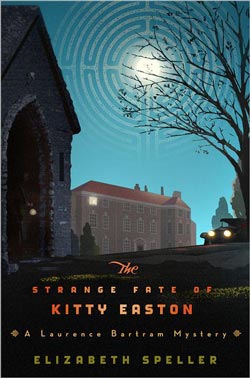
When former infantry officer Laurence Bartram arrives in the village of Easton Deadall, he is struck by the beauty of the place: a crumbling stately home; a centuries-old church; and a work-in-progress memorial to the village’s soldiers, almost all of whom died in one heroic battle in 1916. Now the Great War is over, and the rest of the country is newly alight with hope, but the village remains haunted by tragedy. As does the Easton family: in 1911, five-year-old Kitty Easton disappeared from her bed and has not been seen since; only her fragile mother still believes she is alive. While Laurence is a guest of the Eastons, a young maid in service vanishes—a sinister echo of Kitty’s disappearance. And when an unknown woman’s body is discovered at the entrance of an ancient underground labyrinth, Laurence is drawn into the shadows where family secrets fester, and more than one life may be at stake.
The Strange Fate of Kitty Easton by Elizabeth Speller, is the second in a mystery series set in the years after World War I, featuring a former infantry officer, Laurence Bartram, as amateur detective. Readers new to the series needn’t worry that they’ll be lost; Speller does an admirable job of re-establishing Bartram’s character without dull recapitulation.
In this installment, Bartram has just completed a stint as schoolmaster and is considering taking a job as a tutor in Italy, a big departure from his previous life. With that decision on the horizon, he visits the village of Easton Deadall to consult on a memorial to the local soldiers who died in France. While looking to the future, he must also reflect on the past, very present because almost all of the men of a certain age who lived there died. The village is also haunted by the long-past tragedy of a child, Kitty Easton, who disappeared from her bed.
What I found most striking about the novel is how tightly Speller winds the plot into the historical time period. Every person in the story has been affected by World War I in one way or another, by the deaths of loved ones, by permanent injury, and by lingering grief at the losses of both people and a way of life. They’re having a difficult time moving forward.
The proposed memorial includes an outdoor yew maze that none of the present generation will see in its full growth; their grief will underlie the maze, something permanent even if later generations forget the reason for its existence. It offers potential to navigate emotions, not at present, but in some future that hasn’t yet been imagined.
At the same time, mazes mean something different to a former soldier, and he wonders what the physical remains of the war and its aftermath will mean to future generations.
Laurence was recalling the twists and turns of trenches: some newly dug raw earth, some with explosives set to destroy any intruder, some stinking with the rotting corpses of men and horses, or simply lethally deep in water and mud. He didn’t think anyone would have chosen a maze as a memorial, whatever its long association with Easton Hall, had they served in the infantry.
… Laurence wondered what future historians would make of the landscape of death they’d created in France and Flanders and Turkey: the fortifications, the bones, the weapons. Would somebody stand in those places in centuries to come, excited at the extraordinary nature of what lay around him? Would he puzzle over what its creators thought they were doing as he sifted through fragments of men and metal, horses and ruined timber? Would he think these early twentieth-century people had been trying to appease some particularly cruel god?
The loss of young Kitty Easton is another example of unresolved emotions, lost in a maze; her unknown fate seems inextricable from the ultimate fate of the village and its people.
He was interrupted by Julian. ‘The thing I can’t let go of is that she is somewhere. She wasn’t just magicked away. She was a real child.’ His voice was carefully controlled but the look he gave them was of pure bewilderment. ‘Either she wandered away or someone took her. Either she’s dead or she’s alive. Either she is still in Easton or she’s not.’
Another character notes:
‘Sometimes,’ Frances said, ‘I feel as if Easton will never recover until we—Lydia, Julian, Patrick and me—are dead, and all our memories with us. Kitty dominates everything we do. A little girl who has been gone for over twice as long as she was with us, whose strange afterlife leaves a sort of smothering blanket of guilt over all of us. Even Patrick, who can’t bear to come here more than once every few years.’
The Strange Fate of Kitty Easton is a deeply thoughtful novel and one to be savored on several levels.
Victoria Janssen is the author of three novels and numerous short stories. She has a World War I-set Spice Brief out in May titled “Under Her Uniform,” a tie-in to her novel The Moonlight Mistress. Follow her on Twitter: @victoriajanssen or find out more at victoriajanssen.com.
